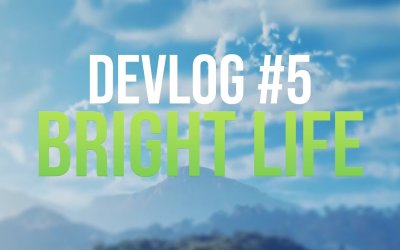In 2004, The Game Creators published a nifty piece of software called PlantLife.
It allowed game developers to rapidly generate 3D plant models with LODs, UVs and materials.
In fact, it only takes a few clicks to create vegetation such as flowers, ferns, and mushrooms that are ready to be exported and used.
TGC’s PlantLife vs. SpeedTree & PlantFactory
Today, we have tools like SpeedTree and PlantFactory that dominate the market.
And while they are incredibly powerful, they can be tricky to use, requiring considerable time for beginners to learn.
Not to mention that these tools aren’t exactly cheap. Both SpeedTree and PlantFactory will set you back $200 a year, and that’s just for an indie license.
By comparison, PlantLife was Just 50 bucks. And since this was during the time when software subscriptions weren’t a thing, once you bought it, it was yours forever.
Bright Life – A New Solution
The quality of textures and geometry is certainly nothing to get excited about by today’s standards.
After all, this technology was from the days of Direct X7 when everything had to be low poly, and textures above 1k resolution were rare.
However, even with these limitations, it’s still possible to produce solid results, provided you spend some time making custom materials.
It’s far from perfect, but considering these ferns only took about 60 seconds to make, the speed is impressive. And even modern-day tools have yet to come close to what PlantLife achieved nearly 20 years ago.
For those wondering where you can find PlantLife today, you’re out of luck.
Development ceased in 2006, and The Game Creators have since moved on to other projects like GameGuru and AppGameKit.
In fact, the only trace left on the internet is this tiny jpg from a 2004 November Newsletter.
That’s why I think a new plant generation solution is needed – one that keeps the speed and simplicity of PlantLife while also supporting more advanced features available in modern technologies.
And since such a tool doesn’t seem to exist, I’m going to build it from scratch.
Programming Language Selection
PlantLife was originally written in a programming language called Blitz3D, which was itself built off BASIC.
Back then, BASIC was still being widely used thanks to its simplicity. But over time, rising demand for more powerful programming languages ultimately saw adoption fall in favour of C and C++.
That’s why this project is going to be written in C++, with OpenGL handling everything on the GPU.
I’m also going to be using my own Bright Engine SDK to handle all the asset importing and rendering, this is to save time and eliminate reliance on 3rd party libraries as much as possible.
Final Thoughts
Bright Life is ambitious and will take some time to complete. But given the continued demand for unique vegetation from the indie development community, I feel it’s a worthwhile endeavour.
And to top it off, anyone who subscribes to follow this development journey will get a copy for free once it’s ready. Comment below if you have any specific feature requests, and I’ll see you in the next one.


